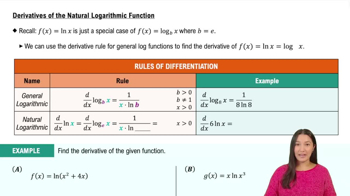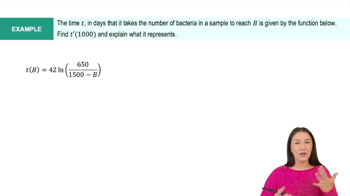Table of contents
- 0. Functions7h 52m
- Introduction to Functions16m
- Piecewise Functions10m
- Properties of Functions9m
- Common Functions1h 8m
- Transformations5m
- Combining Functions27m
- Exponent rules32m
- Exponential Functions28m
- Logarithmic Functions24m
- Properties of Logarithms34m
- Exponential & Logarithmic Equations35m
- Introduction to Trigonometric Functions38m
- Graphs of Trigonometric Functions44m
- Trigonometric Identities47m
- Inverse Trigonometric Functions48m
- 1. Limits and Continuity2h 2m
- 2. Intro to Derivatives1h 33m
- 3. Techniques of Differentiation3h 18m
- 4. Applications of Derivatives2h 38m
- 5. Graphical Applications of Derivatives6h 2m
- 6. Derivatives of Inverse, Exponential, & Logarithmic Functions2h 37m
- 7. Antiderivatives & Indefinite Integrals1h 26m
- 8. Definite Integrals3h 25m
6. Derivatives of Inverse, Exponential, & Logarithmic Functions
Derivatives of Exponential & Logarithmic Functions
Problem 3.9.97c
Textbook Question
97–100. Logistic growth Scientists often use the logistic growth function P(t) = P₀K / P₀+(K−P₀)e^−r₀t to model population growth, where P₀ is the initial population at time t=0, K is the carrying capacity, and r₀ is the base growth rate. The carrying capacity is a theoretical upper bound on the total population that the surrounding environment can support. The figure shows the sigmoid (S-shaped) curve associated with a typical logistic model. <IMAGE>
{Use of Tech} Gone fishing When a reservoir is created by a new dam, 50 fish are introduced into the reservoir, which has an estimated carrying capacity of 8000 fish. A logistic model of the fish population is P(t) = 400,000 / 50+7950e^−0.5t, where t is measured in years.
c. How fast (in fish per year) is the population growing at t=0? At t=5?
 Verified step by step guidance
Verified step by step guidance1
Identify the logistic growth function given in the problem: P(t) = 400,000 / (50 + 7950e^(-0.5t)).
To find the growth rate of the population at a specific time, we need to calculate the derivative of P(t) with respect to t, denoted as P'(t).
Use the quotient rule for differentiation, which states that if you have a function in the form of f(t) = g(t)/h(t), then f'(t) = (g'(t)h(t) - g(t)h'(t)) / (h(t))^2.
Substitute g(t) = 400,000 and h(t) = 50 + 7950e^(-0.5t) into the quotient rule to find P'(t).
Evaluate P'(t) at t=0 and t=5 to find the growth rate of the fish population at those specific times.
Recommended similar problem, with video answer:
 Verified Solution
Verified SolutionThis video solution was recommended by our tutors as helpful for the problem above
Video duration:
7mPlay a video:
Was this helpful?

 4:50m
4:50mWatch next
Master Derivatives of General Exponential Functions with a bite sized video explanation from Callie
Start learningRelated Videos
Related Practice














